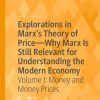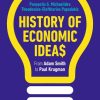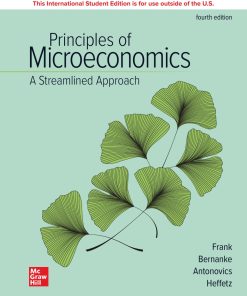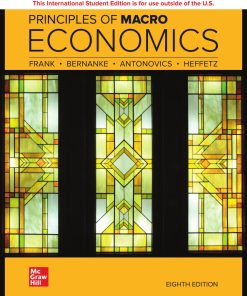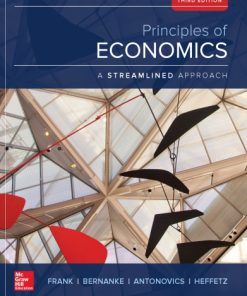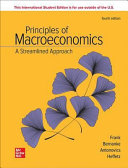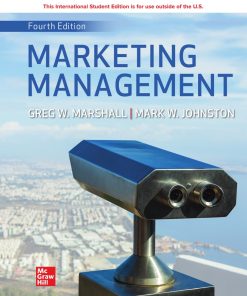(Ebook PDF) Principles of Economics A Streamlined Approach ISE 4th edition by Robert Frank ISBN 9781264363476 1264363478 full chapters
$50.00 Original price was: $50.00.$25.00Current price is: $25.00.
(Ebook PDF) Principles of Economics A Streamlined Approach ISE 4 edition by Robert Frank-Ebook PDF Instant Download/Delivery:9781264363476, 1264363478
Instant download Full Chapter of Principles of Economics A Streamlined Approach ISE 4th edition after payment
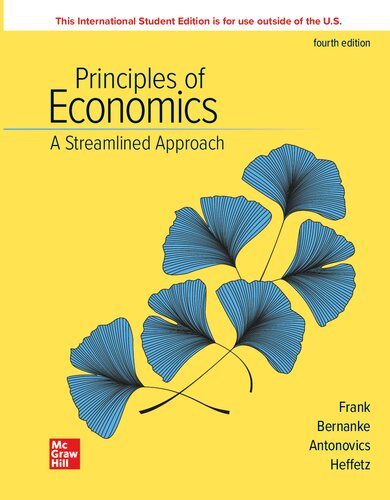
Product details:
ISBN 10: 1264363478
ISBN 13: 9781264363476
Author: Robert H. Frank
Table of contents:
- Chapter 1 Thinking Like an Economist
- Economics: Studying Choice in a World of Scarcity
- Applying the Cost-Benefit Principle
- Economic Surplus
- Opportunity Cost
- The Role of Economic Models
- Three Important Decision Pitfalls
- Pitfall 1: Measuring Costs and Benefits as Proportions Rather than Absolute Dollar Amounts
- Pitfall 2: Ignoring Implicit Costs
- Pitfall 3: Failing to Think at the Margin
- Normative Economics versus Positive Economics
- Economics: Micro and Macro
- The Approach of This Text
- Economic Naturalism
- THE ECONOMIC NATURALIST 1.1
- THE ECONOMIC NATURALIST 1.2
- THE ECONOMIC NATURALIST 1.3
- Summary
- Key Terms
- Review Questions
- Problems
- Answers to Self-tests
- Appendix: Working with Equations, Graphs, and Tables
- Chapter 2 Supply and Demand
- What, How, and for Whom? Central Planning versus the Market
- Buyers and Sellers in Markets
- The Demand Curve
- The Supply Curve
- Market Equilibrium
- Rent Controls Reconsidered
- Pizza Price Controls?
- Predicting and Explaining Changes in Prices and Quantities
- Shifts in Demand
- THE ECONOMIC NATURALIST 2.1
- Shifts in the Supply Curve
- THE ECONOMIC NATURALIST 2.2
- Four Simple Rules
- THE ECONOMIC NATURALIST 2.3
- Efficiency and Equilibrium
- Cash on the Table
- Smart for One, Dumb for All
- THE ECONOMIC NATURALIST 2.4
- Summary
- Key Terms
- Review Questions
- Problems
- Answers to Self-tests
- Appendix: The Algebra of Supply and Demand
- Chapter 3 Demand and Elasticity
- The Law of Demand
- The Origins of Demand
- Needs versus Wants
- THE ECONOMIC NATURALIST 3.1
- Applying the Law of Demand
- Substitution at Work
- THE ECONOMIC NATURALIST 3.2
- THE ECONOMIC NATURALIST 3.3
- THE ECONOMIC NATURALIST 3.4
- The Importance of Income Differences
- THE ECONOMIC NATURALIST 3.5
- Individual and Market Demand Curves
- Horizontal Addition
- Elasticity
- Price Elasticity of Demand
- Price Elasticity Defined
- Determinants of Price Elasticity of Demand
- some representative elasticity estimates
- Using Price Elasticity of Demand
- The Economic Naturalist 3.6
- The Economic Naturalist 3.7
- A Graphical Interpretation of Price Elasticity
- Price Elasticity Changes along a Straight-Line Demand Curve
- Two Special Cases
- Elasticity and Total Expenditure
- Income Elasticity and Cross-Price Elasticity of Demand
- Summary
- Key Terms
- Review Questions
- Problems
- Answers to Self-tests
- Chapter 4 Perfectly Competitive Supply
- Thinking about Supply: The Importance ofOpportunity Cost
- Individual and Market Supply Curves
- Profit-Maximizing Firms in Perfectly Competitive Markets 95
- Profit Maximization
- The Demand Curve Facing a Perfectly Competitive Firm
- Production in the Short Run
- Choosing Output to Maximize Profit
- Price Equals Marginal Cost: The Seller’s Supply Rule
- Graphing Marginal Cost
- The “Law” of Supply
- Applying the Theory of Supply
- The Economic Naturalist 4.
- Determinants of Supply Revisited
- Technology
- Input Prices
- The Number of Suppliers
- Expectations
- Changes in Prices of Other Products
- The Price Elasticity of Supply
- Determinants of Supply Elasticity
- The Economic Naturalist 4.2
- Unique and Essential Inputs: The Ultimate Supply Bottleneck
- Summary
- Key Terms
- Chapter 5 Efficiency, Exchange, and the Invisible Hand in Action
- The Central Role of Economic Profit
- Three Types of Profit
- The Invisible Hand Theory
- Two Functions of Price
- Responses to Profits and Losses
- The Effect of Market Forces on Economic Profit
- The Importance of Free Entry and Exit
- The Invisible Hand in Action
- The Economic Naturalist 5.
- Economic Rent versus Economic Profit
- The Distinction between an Equilibrium and a Social Optimum
- Smart for One, Dumb for All
- The Economic Naturalist 5.2
- Market Equilibrium and Efficiency
- The Cost of Preventing Price Adjustments
- Summary
- Key Terms
- Review Questions
- Problems
- Answers to Self-tests
- Chapter 6 Monopoly, Oligopoly, and Monopolistic Competition
- Perfect and Imperfect Competition
- Different forms of Imperfect Competition
- The Essential Difference between Perfectly and Imperfectly Competitive Firms
- Five Sources of Market Power
- Exclusive Control over Important Inputs
- Patents and Copyrights
- Government Licenses or Franchises
- Economies of Scale and Natural Monopolies
- Network Economies
- Economies of scale and the importance of start-Up costs
- The Economic Naturalist 6.
- Profit Maximization for the Monopolist
- Marginal Revenue for the Monopolist
- The Monopolist’s Profit-Maximizing Decision Rule
- Being a Monopolist Doesn’t Guarantee an Economic Profit
- Why the Invisible Hand Breaks Down underMonopoly
- Using Discounts to Expand the Market
- Price Discrimination Defined
- The Economic Naturalist 6.2
- How Price Discrimination Affects Output
- The Hurdle Method of Price Discrimination
- Is Price Discrimination a Bad Thing?
- Examples of Price Discrimination
- The Economic Naturalist 6.
- Summary
- Key Terms
- Review Questions
- Problems
- Answers to Self-tests
- Chapter 7 Games and Strategic Behavior
- Using Game Theory to Analyze Strategic Decisions
- The Three Elements of a Game
- Nash Equilibrium
- The Prisoner’s Dilemma
- The Original Prisoner’s Dilemma
- The Economics of Cartels
- The Economic Naturalist 7.1
- Tit-for-Tat and the Repeated Prisoner’s Dilemma
- The Economic Naturalist 7.
- The Economic Naturalist 7.
- Games in Which Timing Matters
- Credible Threats and Promises
- Monopolistic Competition When Location Matters
- The Economic Naturalist 7.
- Commitment Problems
- Solving Commitment Problems with Psychological Incentives
- Summary
- Key Terms
- Review Questions
- Problems
- Answers to Self-tests
- Chapter 8 An Introduction to Behavioral Economics
- Judgmental Heuristics or Rules of Thumb
- Availability
- Representativeness
- Regression to the Mean
- The Economic Naturalist 8.1
- Anchoring and Adjustment
- Misinterpretation of Contextual Clues
- The Psychophysics of Perception
- The Difficulty of Actually Deciding
- Impulse-Control Problems
- The Economic Naturalist 8.
- Loss Aversion and Status Quo Bias
- The Economic Naturalist 8.
- Concerns about Relative Position
- The Economic Naturalist 8.
- The Economic Naturalist 8.
- Summary
- Key Terms
- Review Questions
- Problems
- Answers to Self-tests
- Chapter 9 Externalities and Property Rights
- External Costs and Benefits
- How Externalities Affect Resource Allocation
- The Coase Theorem
- Remedies for Externalities
- Laws and Regulations
- The Economic Naturalist 9.1
- The Optimal Amount of Negative Externalities Is Not Zero
- Compensatory Taxes and Subsidies
- The Economic Naturalist 9.
- Property Rights and the Tragedy of the Commons
- The Problem of Unpriced Resources
- The Effect of Private Ownership
- When Private Ownership Is Impractical
- The Economic Naturalist 9.
- The Economic Naturalist 9.
- Positional Externalities
- Payoffs That Depend on Relative Performance
- The Economic Naturalist 9.5
- Positional Arms Races and Positional Arms Control Agreements
- Social Norms as Positional Arms Control Agreements
- Summary
- Key Terms
- Review Questions
- Problems
- Answers to Self-tests
- Chapter 10 Using Economics to Make Better Policy Choices
- The Economics of Health Care
- The Case for Mandatory Immunization Laws
- Explaining Rising Health Care Costs
- Designing a Solution
- The HMO Revolution
- The Economic Naturalist 10.1
- The Problem with Health Care Provision through Private Insurance
- The Affordable Care Act of
- Using Price Incentives in Environmental Regulation
- Taxing Pollution
- Auctioning Pollution Permits
- Climate Change and Carbon Taxes
- Methods of Income Redistribution
- Welfare Payments and In-Kind Transfers
- Means-Tested Benefit Programs
- The Negative Income Tax
- Minimum Wages
- The Earned-Income Tax Credit
- Public Employment for the Poor
- A Combination of Methods
- Summary
- Key Terms
- Review Questions
- Problems
- Answers to Self-tests
- Chapter 11 International Trade and Trade Policy
- Comparative Advantage as a Basis for Trade
- A Supply and Demand Perspective on Trade
- Winners and Losers from Trade
- The Economic Naturalist 11.
- Protectionist policies: tariffs and quotas
- Tariffs
- Quotas
- The Economic Naturalist 11.2
- The Inefficiency of Protectionism
- The Economic Naturalist 11.
- Summary
- Key Terms
- Review Questions
- Problems
- Answers to Self-tests
- Chapter 12 Macroeconomics: The Bird’s-Eye View of the Economy
- The Major Macroeconomic Issues
- Economic Growth and Living Standards
- Productivity
- Recessions and Expansions
- Unemployment
- Inflation
- Economic Interdependence among Nations
- Macroeconomic Policy
- Types of Macroeconomic Policy
- Positive versus Normative Analyses of Macroeconomic Policy
- Aggregation
- Studying Macroeconomics: A Preview
- Summary
- Key Terms
- Review Questions
- Problems
- Answers to Self-tests
- Chapter 13 Measuring Economic Activity: GDP, Unemployment, and Inflation
- Gross Domestic Product: Measuring the Nation’s Output
- Market Value
- Final Goods and Services
- Produced in a Country during a Given Period
- Methods for Measuring GDP 307
- The Expenditure Method for Measuring GDP
- GDP and the Incomes of Capital and Labor
- Nominal GDP versus Real GDP
- The Economic Naturalist 13.1
- Real Gdp, Economic Growth, and Economic Well-Being
- Unemployment and the Unemployment Rate
- Measuring Unemployment
- The Costs of Unemployment
- The Duration of Unemployment
- The Unemployment Rate versus “True” Unemployment
- The Consumer Price Index and Inflation 320
- Inflation
- Adjusting for Inflation
- Deflating a Nominal Quantity
- Indexing to Maintain Buying Power
- The Economic Naturalist 13.
- Inflation Measurement and Quality Change
- The Costs of Inflation: Not What You Think
- The True Costs of Inflation
- Summary
- Key Terms
- Review Questions
- Problems
- Answers to Self-tests
- Chapter 14 Economic Growth, Productivity, and Living Standards
- The Remarkable Rise in Living Standards: The Record
- Why “Small” Differences in Growth Rates Matter
- Why Nations Become Rich: The Crucial Role of Average Labor Productivity
- The Determinants of Average Labor Productivity
- Human Capital
- The Economic Naturalist 14.1
- Physical Capital
- Land and Other Natural Resources
- Technology
- The Economic Naturalist 14.2
- Entrepreneurship and Management
- The Economic Naturalist 14.3
- The Political and Legal Environment
- Real Gdp and Economic Well-Being 357
- Why Real gdp Isn’t the Same as Economic Well-Being
- The Economic Naturalist 14.4
- But Gdp Is Related to Economic Well-Being
- The Economic Naturalist 14.
- Promoting Economic Growth
- Policies to Increase Human Capital
- The Economic Naturalist 14.6
- Policies That Promote Saving and Investment
- Policies That Support Research and Development
- The Legal and Political Framework
- The Poorest Countries: A Special Case?
- Are There Limits to Growth?
- Summary
- Key Terms
- Review Questions
- Problems
- Answers to Self-tests
- Chapter 15 The Labor Market: Workers, Wages, and Unemployment
- Five Important Labor Market Trends
- Trends in Real Wages
- Trends in Employment and Unemployment
- Supply and Demand in the Labor Market 376
- Wages and the Demand for Labor
- Shifts in the Demand for Labor
- The Economic Naturalist 15.1
- The Supply of Labor
- Shifts in the Supply of Labor
- Explaining the Trends in Real Wages and Employment
- Large Increases in Real Wages in Industrialized Countries
- Real Wage Growth in the United States Has Stagnated since the Early 1970s, While Employment Growth Has Been Rapid
- Increasing Wage Inequality: The Effects of Globalization and Technological Change
- The Economic Naturalist 15.
- Unemployment
- Types of Unemployment and Their Costs
- Impediments to Full Employment
- Summary
- Key Terms
- Review Questions
- Problems
- Answers to Self-tests
- Chapter 16 Saving and Capital Formation
- Saving and Wealth
- Stocks and Flows
- Capital Gains and Losses
- The Economic Naturalist 16.
- The Economic Naturalist 16.
- Why Do People Save?
- The Economic Naturalist 16.3
- Saving and the Real Interest Rate
- Saving, Self-Control, and Demonstration Effects
- The Economic Naturalist 16.
- National Saving and Its Components
- The Measurement of National Saving
- Private and Public Components of National Saving
- Public Saving and the Government Budget
- Is Low Household Saving a Problem?
- Investment and Capital Formation
- Saving, Investment, and Financial Markets
- The Economic Naturalist 16.
- Summary
- Key Terms
- Review Questions
- Problems
- Answers to Self-tests
- Chapter 17 Money, the Federal Reserve, and Global Financial Markets
- Money and its Uses
- The Economic Naturalist 17.1
- Measuring Money
- Commercial Banks and the Creation of Money
- The Money Supply with Both Currency and Deposits
- The Federal Reserve System 444
- The History and Structure of the Federal Reserve System
- Controlling the Money Supply: Open-Market Operations
- The Fed’s Role in Stabilizing Financial Markets: Banking Panics
- The Economic Naturalist 17.
- The Financial System and the Allocation of Saving to Productive Uses
- The Banking System
- The Economic Naturalist 17.3
- Bonds and Stocks
- Bond Markets, Stock Markets, and the Allocation of Savings
- The Informational Role of Bond and Stock Markets
- Risk Sharing and Diversification
- The Economic Naturalist 17.
- International Capital Flows
- Capital Flows and the Balance of Trade
- The Determinants of International Capital Flows
- Saving, Investment, and Capital Inflows
- The Saving Rate and the Trade Deficit
- The Economic Naturalist 17.
- Summary
- Key Terms
- Review Questions
- Problems
- Answers to Self-tests
- Chapter 18 Short-Term Economic Fluctuations and Fiscal Policy
- The Economic Naturalist 18.
- Recessions and Expansions
- The Economic Naturalist 18.2
- Some Facts about Short-Term Economic Fluctuations
- Output Gaps and Cyclical Unemployment
- Potential Output
- The Output Gap
- The Natural Rate of Unemployment and Cyclical Unemployment
- The Economic Naturalist 18.
- Why Do Short-Term Fluctuations Occur? A Preview and a Tale
- Alice’s Ice Cream Store: A Tale about Short-Run Fluctuations
- Recessions and Proposed Solutions: Keynes’s Analysis
- The Keynesian Model’s Crucial Assumption: Firms Meet Demand at Preset Prices
- The Economic Naturalist 18.4
- Aggregate Output and Spending
- Hey Big Spender! Consumer Spending and the Economy
- The Multiplier
- Stabilizing Spending: The Role of Fiscal Policy
- Government Purchases and Spending
- THE ECONOMIC NATURALIST 18.5
- Taxes, Transfers, and Aggregate Spending
- The Economic Naturalist 18.
- Fiscal Policy as a Stabilization Tool: Three Qualifications
- Fiscal Policy and the Supply Side
- The Problem of Deficits
- The Relative Inflexibility of Fiscal Policy
- Summary
- Key Terms
- Review Questions
- Problems
- Answers to Self-tests
- Chapter 19 Stabilizing the Economy: The Role of the Fed
- The Federal Reserve and Interest Rates: The Basic Model
- The Demand for Money
- Macroeconomic Factors That Affect the Demand for Money
- The Money Demand Curve
- The Economic Naturalist 19.1
- The Supply of Money and Money Market Equilibrium
- How the Fed Controls the Nominal Interest Rate
- The Role of the Federal Funds Rate in Monetary Policy
- Can the Fed Control the Real Interest Rate?
- The Federal Reserve and Interest Rates: A Closer Look
- Can the Fed Fully Control the Money Supply?
- Do Interest Rates Always Move Together?
- The Effects of Federal Reserve Actions on the Economy
- Aggregate Expenditure and the Real Interest Rate
- The Fed Fights a Recession
- The Economic Naturalist 19.2
- The Fed Fights Inflation
- The Economic Naturalist 19.
- The Economic Naturalist 19.
- The Economic Naturalist 19.5
- The Fed’s Policy Reaction Function
- The Economic Naturalist 19.
- Monetary Policymaking: Art or Science?
- Summary
- Key Terms
- Review Questions
- Problems
- Answers to Self-tests
- Chapter 20 Aggregate Demand, Aggregate Supply, and Inflation
- Inflation, Spending, and Output: The Aggregate Demand Curve
- Inflation, the Fed, and Why the AD Curve Slopes Downward
- Other Reasons for the Downward Slope of the AD Curve
- Factors That Shift the Aggregate Demand Curve
- Shifts of the AD Curve versus Movements along the AD Curve
- Inflation and Aggregate Supply
- Inflation Inertia
- The Output Gap and Inflation
- The Aggregate Demand–Aggregate Supply Diagram
- The Self-Correcting Economy
- Sources of Inflation 560
- Excessive Aggregate Spending
- The Economic Naturalist 20.1
- Inflation Shocks
- The Economic Naturalist 20.2
- Shocks to Potential Output
- The Economic Naturalist 20.3
- Controlling Inflation
- The Economic Naturalist 20.
- The Economic Naturalist 20.
- Summary
- Key Terms
- Review Questions
- Problems
- Answers to Self-tests
- Chapter 21 Exchange Rates and the Open Economy
- Exchange Rates
- Nominal Exchange Rates
- Flexible versus Fixed Exchange Rates
- The Real Exchange Rate
- The Economic Naturalist 21.
- The Determination of the Exchange Rate in the Long Run 587
- A Simple Theory of Exchange Rates: Purchasing Power Parity (PPP)
- Shortcomings of the PPP Theory
- The Determination of the Exchange Rate in the Short Run
- The Foreign Exchange Market: A Supply and Demand Analysis
- Changes in the Supply of Dollars
- Changes in the Demand for Dollars
- The Economic Naturalist 21.
- Monetary Policy and the Exchange Rate
- The Economic Naturalist 21.3
- The Exchange Rate as a Tool of Monetary Policy
- Fixed Exchange Rates 597
- How to Fix an Exchange Rate
- Speculative Attacks
- Monetary Policy and the Fixed Exchange Rate
- The Economic Naturalist 21.
- The Economic Naturalist 21.
- The Economic Naturalist 21.
- Should Exchange Rates Be Fixed or Flexible?
- The Economic Naturalist 21.
- Summary
- Key Terms
People also search:
principles of economics a streamlined approach 4th edition
principles of economics a streamlined approach pdf
what are the principles of economics
4 basic principles of economics
economic principles definition
Tags:
Principles of Economics,Streamlined Approach ISE,Robert Frank
You may also like…
Business & Economics - Economics
Principles of Microeconomics 8th/ISE Edition Robert H. Frank
Business & Economics
Business & Economics - Economics
Principles of Microeconomics: A Streamlined Approach 4th Edition Robert 1264058845 9781264058846
Business & Economics - Economics
Business & Economics - Economics
Principles of Economics, 8e ISE 8th/ISE Edition Robert H. Frank
Business & Economics
Biology and other natural sciences - Biology
Business & Economics - Sales & Marketing


